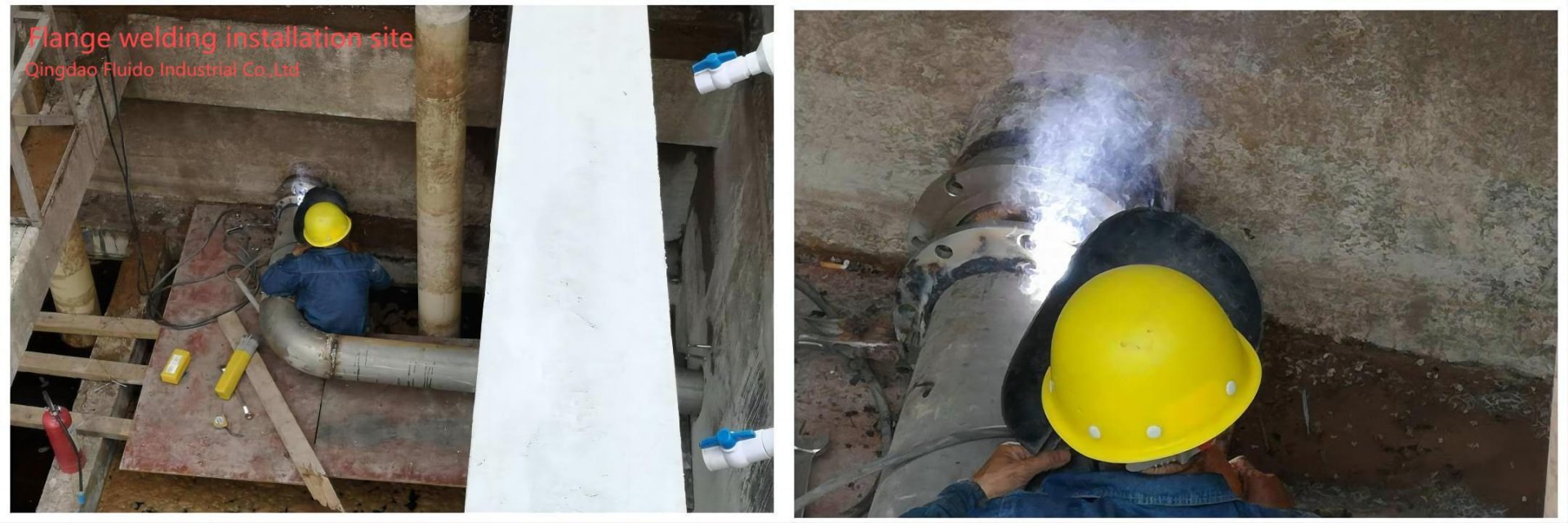Export Office: 21Floor, No.5 Nanhai Zhi Road,Qingdao, Shandong ,China
Work Shop: Beian Industrial zone, Qingdao,Shandong,China
+86 532 88550858
Martin
Inquiry now
Flat face flanges are a specific type of flange characterized by their smooth, even surface. These flanges play a crucial role in connecting pipes, valves, and various components within a piping system. The flat surface ensures that the gasket rests flush against both flange faces, facilitating an even distribution of pressure across the sealing area. This design is particularly advantageous in situations where a raised face could undermine the seal's integrity. Unlike other flange types, flat face flanges are engineered to minimize gaps and reduce potential leaks, rendering them ideal for particular applications within piping systems.
As a leading manufacturer and exporter specialized in steel valves, fittings, pipe couplings and flanges, FLUIDO has been serving 35+ countries/regions for over 20 years. In addition to manufacturing its own flanges, FLUIDO also established partnership with factories in Shandong and Hebei, so as to provide customers with a full range of products and one-stop sourcing services.
Flat face flanges are extensively utilized across diverse industrial sectors. Predominantly employed within water treatment facilities, they ensure a secure seal to avert leakage and preserve system integrity. Their application extends to low-pressure piping systems and environments containing materials that may corrode other flange surfaces. Furthermore, these flanges are highly favored in marine operations due to their capacity to deliver reliable seals, capable of withstanding the harsh and corrosive conditions frequently encountered at sea where high-performance standards are imperative.
First, their simple design makes them easy to install, reducing the time and labor costs associated with more complex flange types. Secondly, the flat surface ensures a more even pressure distribution when bolting, which helps to create a more reliable seal. This is particularly important in systems where the seal integrity is critical to preventing leaks and maintaining operational efficiency. Another benefit is their versatility in compatibility with various kinds of gaskets, including non-metallic ones, ensuring a robust seal across different materials. Finally, flat face flanges are cost-effective, making them a preferred choice in many low-pressure and non-demanding applications.
Several essential tools are necessary for the proper installation of flat face flanges. To begin with, a torque wrench is indispensable for ensuring that bolts are tightened to the correct specifications. This tool helps in applying even pressure across the flange, which is crucial for maintaining the integrity of the seal. In addition to the torque wrench, a pipe cleaner or wire brush is needed to clean the pipe surface before installation. This helps remove any debris, rust, or other contaminants that could compromise the seal. Other essential tools include a flange alignment tool for correctly aligning the flange with the pipe and a set of wrenches or spanners for tightening and securing the bolts.
The materials necessary for securing flat face flanges go beyond just the flanges themselves. One critical component is the gasket, which sits between the flanges to create a tight seal. Depending on the specific application and the materials being handled by the piping system, different types of gaskets may be used, such as non-metallic gaskets for less demanding applications. Bolts and nuts are also crucial materials, and these must be selected based on the flange size and pressure requirements of the piping system. It's essential to use bolts and nuts made from materials that are compatible with the flange and the pipe to prevent corrosion and ensure a secure connection. Lubricants or anti-seize compounds can also be beneficial for preventing galling and making future disassembly easier.
Before starting the installation of flat face flanges, it's critical to prepare the pipe surface properly. This involves thoroughly cleaning the pipe surface to remove any dirt, debris, rust, or old gasket material that might be present. Using a wire brush or a pipe cleaner can be effective for this purpose. The objective is to ensure that the surface is smooth and free of contaminants, which could interfere with the flange's ability to form a secure and reliable seal.
Once the pipe surface is clean, the next step is to inspect the flange itself. Check for any signs of damage such as cracks, dents, or warping, as even minor imperfections can compromise the integrity of the seal. It's essential to address any damage before proceeding with the installation. If the flange appears compromised, replacing it with a new one is advisable to avoid potential leaks or failures in the system. Ensuring the flange is in good condition will help maintain the reliability of the piping system.
For the sake of meeting strict quality requirements and industry standards, FLUIDO is certified to the international ISO9001 quality system standard and all products are carefully tested before shipment. Since “trust originates from quality”, we have passed not only the European CE certification for our valves and flanges products, but also the ISO9001 assessment and registration by SGS for quality management.
After inspecting the flange, the next step is to place the gasket between the pipe and the flange. Care must be taken to center the gasket properly, ensuring that it covers the entire area between both flange faces without any overhang. A well-centered gasket is crucial for creating an even pressure distribution when the bolts are tightened, thereby enhancing the seal's effectiveness. Misalignment can lead to gaps or uneven pressure, which might result in leaks or system failures.
With the gasket in place, the flange must then be aligned with the pipe in such a way that the bolt holes on both surfaces perfectly match. This alignment can be facilitated using a flange alignment tool, ensuring that the flange sits correctly on the pipe without any skew. Proper alignment is vital because any misalignment can cause difficulty in inserting the bolts and could impact the pressure distribution, which may compromise the seal integrity.
Once the flange and gasket are properly aligned, you can proceed to insert the bolts into the matching bolt holes. Initially, the bolts should be hand-tightened to keep the flange in place and ensure that the gasket remains centered. This preliminary hand-tightening helps in maintaining alignment and evenly secures the flange to the pipe. Hand-tightening also allows for a final check to make sure everything is correctly positioned before applying full torque to the bolts.
After hand-tightening the bolts, the next step involves using a torque wrench to achieve even tightening. The torque wrench should be set according to the manufacturer's specifications or industry standards for the specific type of flange and piping system. It's crucial to tighten the bolts in a star or crisscross pattern to distribute the pressure evenly across the flange. This method helps in preventing any warping or squeezing that could disturb the gasket's positioning. Proper use of the torque wrench ensures a secure seal and maintains the structural integrity of the flange connection.

Upon completing the bolting process, an inspection should be conducted to confirm that the seal is secure. Visually inspecting the gasket and the flange connection can help in identifying any potential issues, such as misalignment or uneven pressure distribution. Ensuring that the gasket is uniformly compressed between the flange faces without any visible gaps is essential for maintaining a leak-proof seal. Any discrepancies observed during this inspection should be addressed immediately to avoid future operational problems.
After the initial visual inspection, a more thorough check for leaks should be performed. This can involve pressurizing the piping system and observing the flange connection closely. Any signs of leakage indicate that the bolts may need further tightening or that the gasket is not seated correctly. Some installers use soapy water around the flange area to detect leaks by looking for bubbles forming. Ensuring the flange is free of leaks is crucial before the system is put into full operation.
Finally, after the system has been pressurized and checked for leaks, a secondary tightening of the bolts is often advisable. This step ensures that any initial settling of the gasket or flange under pressure is compensated for, maintaining a secure connection. Use the torque wrench to re-tighten the bolts following the same star pattern to ensure even pressure distribution. A final inspection, both visual and systemic, should be conducted to confirm that everything is securely in place and functioning as intended. This step solidifies the reliability and longevity of the system.
Regular maintenance is crucial for the longevity and performance of the flat face flange connections. Routine checks should include visual inspections for signs of wear, corrosion, or any visible leakage. Scheduled maintenance might also involve re-tightening the bolts to the specified torque settings, especially after the system has been in operation for a while. Maintaining a detailed log of all maintenance activities helps in tracking the performance and identifying any recurring issues that may need addressing.
Over time, various components of the flange connection can show signs of wear and tear. This can include corrosion on the flange faces or the bolts, wear on the gasket, or deformation of the flange surfaces. Identifying these issues early can prevent more severe problems down the line. Regularly inspecting these components and replacing them as needed ensures the overall integrity of the piping system and helps to avoid unexpected shutdowns or failures.
Know more about Qingdao Fluido, please visit www.eathu.com www.fluidovalve.com
Flat flange: https://www.eathu.com/flat-flange.html
Bolt for Flange: https://www.eathu.com/bolt-and-nut-for-flanges.html
Material and price for flange: https://www.eathu.com/price-list-and-tech.html
Export Office: 21Floor, No.5 Nanhai Zhi Road,Qingdao, Shandong ,China
Work Shop: Beian Industrial zone, Qingdao,Shandong,China
+86 532 88550858
Martin
© 2020 Qingdao Fluido Industrial Co.,Ltd. All Rights Reserved. Qingdao fluido valve

